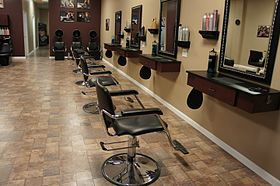
Hairdressers are exposed to lots of harmful airborne chemicals in the products they and others use in hair salons. And it's every day they work, all day. A recent study found that the chemical exposure is especially high for hair stylists serving Black and Latina clients.
The airborne chemicals from the products hairdressers use (e.g., straighteners, relaxers, chemicals in permanents, hair dyes, sprays) are called volatile organic compounds (VOCs). They are air pollutants. These chemicals can pose health risks, such as reproductive effects, respiratory problems, cardiovascular effects, cancer, and skin and respiratory irritation. One common VOC hairdressers are exposed to is formaldehyde.
The study found that the level of VOCs in the air was much, much lower in office spaces not connected to the hair salons. Of course.
From Medical Xpress: Hairstylists serving Black and Latina clients exposed to high concentrations of airborne toxins
Hairstylists, especially those providing services to Black and Latina women, are exposed to high concentrations of harmful airborne chemicals in their workplace, a team of Johns Hopkins researchers has found.
The study, published in the Journal of Environmental Exposure Assessment, is the first to report indoor air concentrations of several volatile organic compounds or VOCs in U.S. hair salons serving this group of women. This builds on previous Johns Hopkins research that found Black and Hispanic hairdressers had higher levels of chemicals from hair relaxers, dyes, and other salon products in their bodies compared to office workers but did not specifically measure air concentrations of the chemicals.
The researchers conducted air monitoring to measure 14 VOCs in three salons serving Black women, three Dominican salons predominantly serving Latina and Black women, and 10 office spaces not connected to salons to serve as a comparison group. Most of the spaces tested had some level of the VOCs the researchers were looking for. However, median VOC concentrations were two to 175 times higher in salons than in offices.
"At the root of the problem are the products used on clients' hair," says Lesliam Quirós-Alcalá, study senior author and associate professor in the Department of Environmental Health and Engineering. "Manufacturers of hair care products need to focus on developing safer options that don't put hairstylists or consumers in harm's way."
Female hairstylists are vulnerable because they tend to be of reproductive age and work during critical periods before and during pregnancy. Many also tend to use products like chemical relaxers, straighteners, and smoothing products, which may pose particular health risks.
Several of the VOCs in these products have been linked in animal studies to neurodevelopmental and reproductive effects, potentially posing health risks for these women and their unborn children. The compounds have also been linked to respiratory and cardiovascular effects, skin irritation, and cancer.
According to Quirós-Alcalá, Black and Latina hairstylists make up about 30% of this predominantly female, low-wage workforce. Many women in this profession face multiple challenges, including exposure to both chemical and non-chemical stressors, such as limited access to health care and health insurance, which can exacerbate their potential health risks. This combination of factors can contribute to environmental health disparities among this demographic.
"While limiting product use could help, it may not always be practical due to client demands and a lack of safer alternatives," says Quirós-Alcalá. "To reduce VOC exposures in hair salons, it is also critical to prioritize adequate ventilation."
Opening doors and windows when available during chemical-intensive services can improve the indoor air quality in salons. Manufacturers recommend that salons use fans and air purifiers, masks, and gloves when providing chemical-intensive services to reduce exposure.
